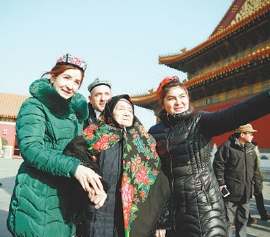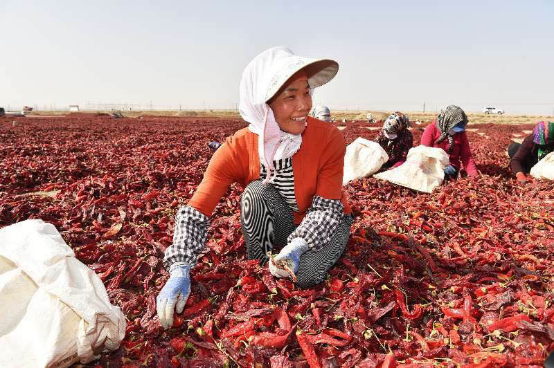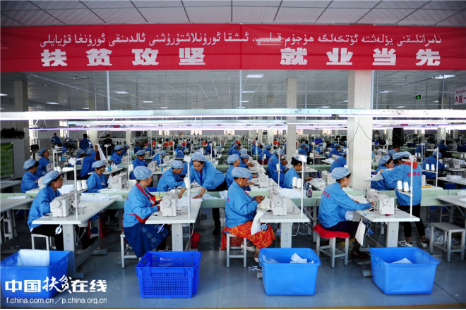
Great granddaughter of Kurban Tulum (fourth left), a Uygur patriot, accompanies a 106-year-old senior Uyghur (third left) to visit the Tian'anmen Rostrum in Beijing, January 19, 2016. The story of Kurban Tulum riding a donkey from Xinjiang to Beijing in the 1950s is widely known in Xinjiang. (Photo by People's Daily)

A bumper harvest of chilies. Photo shows farmers dry chilies in Qigexing Township, Yanqi County, Kuerle City in northwest China's Xinjiang Uygur Autonomous Region, October 5 as the county has entered a harvest season of chilies. (Photo by Lei Sheng from People's Daily)

Uyghur workers make clothes at a clothing factory in an entrepreneurship & employment park in Wuqia Township, Kuche County, Xinjiang Uygur Autonomous Region. (Photo from the official website of China's poverty alleviation work)
"Thanks to the selfless assistance from the Central Government and people of all ethnic groups across the country, my hometown has undergone drastic changes over the past years," a delegate from northwest China's Xinjiang Uyghur Autonomous Region said before the 19th National Congress of the Communist Party of China (CPC) kicked off on Wednesday.
"People there are living in happiness," he told domestic and foreign press, pledging that "we will unite closely like pomegranate seeds".
After the 18th National Congress of the CPC, the Central Committee has put forward a host of important guidelines and policies concerning its work in Xinjiang, pointing out that the general objective of the Xinjiang work is to ensure social stability and long-term peace.
Over the past five years, the work in Xinjiang has made significant strides. According to statistics, the regional GDP has grown from 752.9 billion yuan ($114 billion) in 2012 to 965 billion yuan ($140 billion) in 2016, an average increase of 9.3 percent.
The region's average per capita income has risen from 33,902 yuan ($5,122)in 2012 to 40,564 yuan ($6,129) in 2016, increasing by 7.5 percent on average per year.
Nineteen aid-Xinjiang provinces and cities nationwide have carried out nearly 5,000 projects to help Xinjiang to develop, with a total investment of over 47.5 billion yuan, injecting strong impetus and vitality into Xinjiang’s economic and social development.
Shohrat Zakir, chairman of the regional government, said for many straight years, Xinjiang has been using more than 70 percent of its annual fiscal budgets to improve people's life.
From 2013 to 2016, the number of impoverished people in Xinjiang was reduced from 2.61 million to 1.22 million, with another 590,000 poor population targeted to be lifted out of poverty by the end of this year, the chairman said.
In addition to that, the regional government has rolled out a batch of projects to bring benefits to the people, including rural comfortable housing, settlement of herders and urban affordable housing, he said, adding that it also implemented 15-year free education in southern Xinjiang, promoted full coverage of vocational education and offered free health checks for residents of all ethnic groups within the region.
Xinjiang's status as the "core zone" of the Silk Road Economic Belt has brought greater historical opportunities to the region, said Zakir.
He explained that the place has now ascended from the northmost place in west China to a front gate that the country opens to Central and Western Asia, from a surrounding region to a pivot place in terms of the country’s development.


